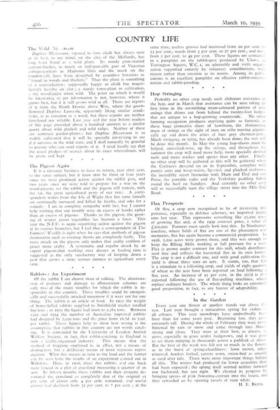Rabbits : An Experiment Of the rabbit I am almost
tirea of talking. The deteriora- tion of pastures and damage to afforestation schemes are only two of the many troubles for which the rabbit is re- sponsible in this country. These troubles could he energeti- cally and successfully attacked tomorrow if it were not for one thing. The rabbit is an article of food. In 1932 the weight of home-killed rabbits supplied to Smithfield market totalled 895 tons ; in 1935 the figure had risen to 2,283 tons. Between 1920 and 1934 the number of Australian imported rabbits had dropped by 2,000 tons and the price from 16.7d. to 5.9d. per rabbit. These figures help to show how wrong is the assumption that rabbits in this country arc not worth catch- ing. It is contended by the University of London Animal Welfare Society, in fact, that rabbit-catching in England is now a highly-organised industry. This means that the method of trapping employed is, in effect, not a means of destruction, but a deliberate means of more vigorous repro- duction. What this means in turn to the land and the farmer can he seen from the results of an experiment carried out in Wiltshire. Here, in 1936, three doe rabbits a•lel one buck were fenced in a plot of grassland measuring a quarter of an acre In fift.. months these rabbits and their progeny de- vastated the grassland so completely that of the original 51 per cent, of clover only 4 per cent. remained, and useful grasses had declined from 32 per cent. to 7 per cent. ; at the same time, useless grasses had increased ftom to per cent. to 13 per cent., weeds from 5 per cent. to 27 per cent., and mei- from 2 per cent. to 49 per cent. These figures are contained in a pamphlet on the rabbit-pest produced by Ulaws, Torrington Square, W.C. t, an admirable and virile organi- sation supported entirely by voluntary contributions, with
reason rather than emotion as its motto. Among its publications is an excellent pamphlet on effective rabbit-extermi- nation and rabbit-proofing.










































 Previous page
Previous page